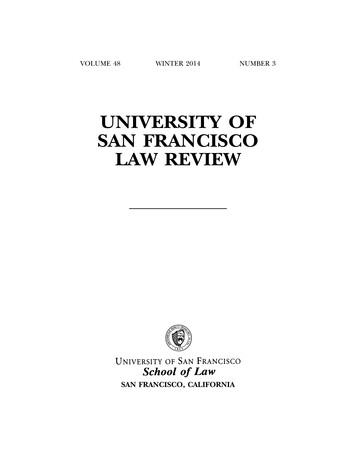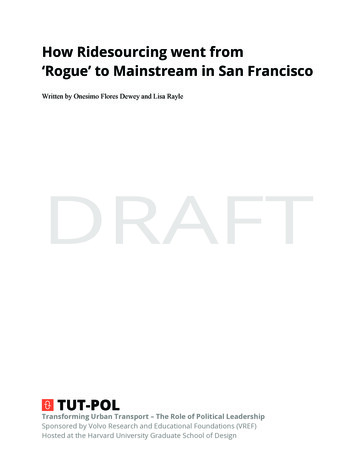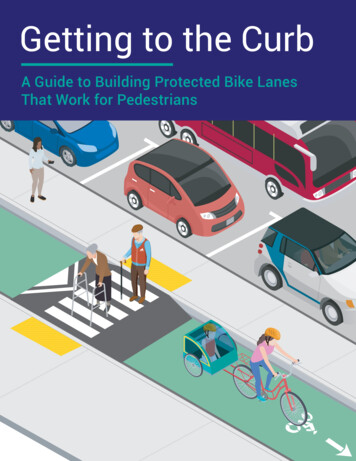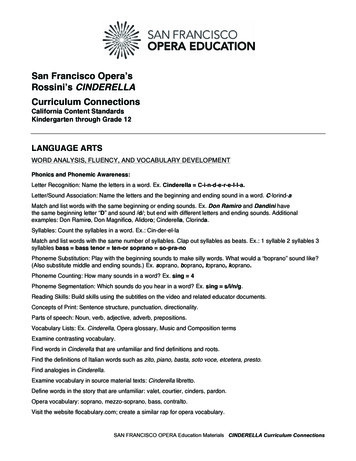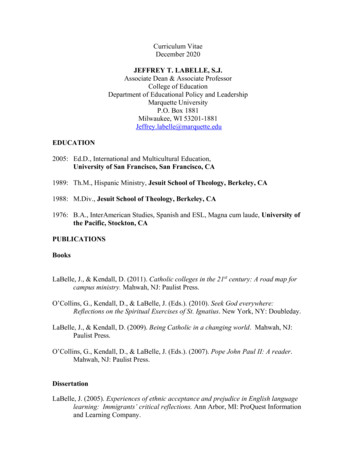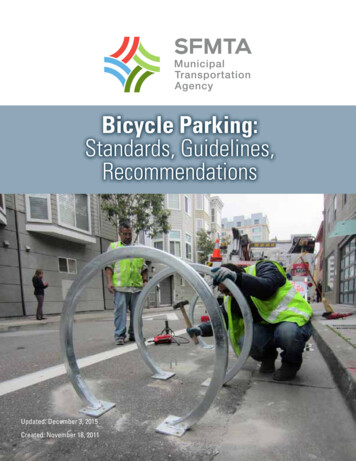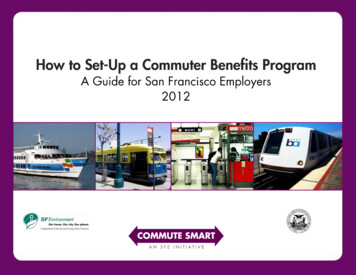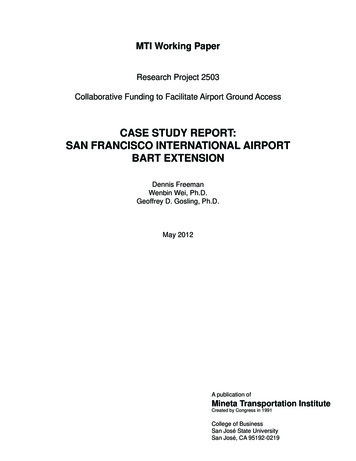
Transcription
MTI Working PaperResearch Project 2503Collaborative Funding to Facilitate Airport Ground AccessCASE STUDY REPORT:SAN FRANCISCO INTERNATIONAL AIRPORTBART EXTENSIONDennis FreemanWenbin Wei, Ph.D.Geoffrey D. Gosling, Ph.D.May 2012A publication ofMineta Transportation InstituteCreated by Congress in 1991College of BusinessSan José State UniversitySan José, CA 95192-0219
ii Mineta Tra n s p o rt a t io n I n s t it u t e
iiiCopyright 2012by Mineta Transportation InstituteAll rights reservedLibrary of Congress Catalog Card Number:2012938608To order this publication, please contact:Mineta Transportation InstituteCollege of BusinessSan José State UniversitySan José, CA 95192-0219Tel: (408) 924-7560Fax: (408) 924-7565Email: mineta-institute@sjsu.edutransweb.sjsu.eduMin e ta Tra n s p o rt a t io n I n s t it u t e
iv Mineta Tra n s p o rt a t io n I n s t it u t e
vACKNOWLEDGMENTSThe case study documented in this report has been prepared as part of the MinetaTransportation Institute Research Project Collaborative Funding to Facilitate Airport GroundAccess. The objectives of the research project include examining and documenting pastexperience with collaborative funding of airport ground access projects and the use ofdifferent funding sources to facilitate interconnectivity between transportation modes inorder to improve airport ground access.The authors would like to acknowledge and thank the sponsors of the research, the CaliforniaDepartment of Transportation, Division of Aeronautics and the Mineta TransportationInstitute (MTI).The authors also thank MTI staff, including deputy executive director and research directorKaren Philbrick, Ph.D.; director of communications and technology transfer Donna Maurillo;student research support assistant Joey Mercado; and webmaster Frances Cherman, whoalso provided editorial support.Helpful suggestions on the presentation of the material in this case study report werereceived from several anonymous reviewers as part of the peer review process for allresearch published by MTI.Min e ta Tra n s p o rt a t io n I n s t it u t e
viAcknowledgmentsMineta Tra n s p o rt a t io n I n s t it u t e
viiTABLE OF CONTENTSIntroduction 1History of the Project 3Early History of the Project4Alternatives Considered4San Francisco Ballot Measures8Public Concerns and Opposition9The Project Design Evolves9Role of Design-Build Contracts10Project Costs 11Funding Sources 11Federal Funding11State and Local Funding12Summary and Conclusions 14Abbreviations and Acronyms 17Endnotes 19Peer Review 23Min e ta Tra n s p o rt a t io n I n s t it u t e
viiiTable of ContentsMineta Tra n s p o rt a t io n I n s t it u t e
ixLIST OF FIGURES1. BART System Map 22. SFO AirTrain System Map 33. BART to SFO Alternatives 5Min e ta Tra n s p o rt a t io n I n s t it u t e
xList of FiguresMineta Tra n s p o rt a t io n I n s t it u t e
xiLIST OF TABLES1. Estimated Capital Costs, Daily Patronage, and Annual Operating andMaintenance Costs of Alternatives 82. BART SFO Extension Funding Allocation 13Min e ta Tra n s p o rt a t io n I n s t it u t e
xiiList of TablesMineta Tra n s p o rt a t io n I n s t it u t e
xiiiABSTRACTThis case study report documents the experience with collaborative funding of airportground access involved in the construction of an extension of the Bay Area Rapid Transit(BART) system to San Francisco International Airport (SFO). The 8-mile extension of theBART system from the Colma station in northern San Mateo County to SFO and Millbraeevolved into a 1.5 billion project that included two intermediate stations in South SanFrancisco and San Bruno, in addition to the airport station and the Millbrae station at thesouthern end of the extension. The Millbrae station provides intermodal connections tothe Caltrain commuter rail service that connects San Francisco to San José and othercommunities in San Mateo and Santa Clara counties. The SFO station is located adjacentto the International Terminal and within walking distance of the domestic terminals andis served by a dead-end spur off the main line. After several decades of planning, andconsiderable controversy over where to locate the airport station, construction of theextension began in November 1997 and the extension opened in June 2003.The project was funded by a combination of federal, state and local funds. By the end ofthe project, federal New Starts funding had covered just over half the project cost, withfunding from SFO covering about 13 percent and various state and local funding sourcesproviding the remainder of the funding. About 24 percent of the funding was provided byBART and SamTrans from internal funds derived from local sales tax increments dedicatedto each agency.The BART extension to SFO provides a good example of airport, regional and statecommitment to leveraging federal New Starts capital investment grants to fund extensionof a regional rapid transit system to a major airport. At the same time, the project illustratesthe technical challenges and compromises that are often involved in bringing rail serviceinto an airport terminal area. The solution that was ultimately adopted of constructing aspur from the main line between San Francisco and Millbrae to the south of the airport hasresulted in a situation where trains serving the airport have to stop and reverse directionin the airport station. On the one hand, this allows the airport station to be located withinwalking distance of the passenger terminal facilities, although many users ride an airportpeople-mover between the station and the passenger terminals. On the other hand, thisadded significantly to the cost of the BART extension to the airport and has created acostly and inefficient operating environment for BART.Min e ta Tra n s p o rt a t io n I n s t it u t e
xivAbstractMineta Tra n s p o rt a t io n I n s t it u t e
1SAN FRANCISCO INTERNATIONAL AIRPORTBART EXTENSIONINTRODUCTIONSan Francisco International Airport (SFO) is the primary commercial service airport in theSan Francisco Bay Area and the principal West Coast hub for United Airlines. The airporthas extensive long haul and international air services and recently has attracted a numberof low-cost airlines, including Virgin America. In 2010 the airport handled 39.1 million airpassengers.1The Bay Area Rapid Transit (BART) heavy rail system currently connects SFO with manymunicipalities in the San Francisco Bay Area. Prior to opening the BART extension to SanMateo County in 1996, the system operated within three Bay Area counties, Alameda,Contra Costa and San Francisco, with the line through San Francisco terminating at DalyCity on the southwest boundary of San Francisco. Originally, when the BART system wasfirst proposed, it was envisaged that the system would serve five counties. However, SanMateo and Marin counties subsequently withdrew from the planned BART District, citingthe high costs of the new system.2 The extension of the system into San Mateo Countyrequired extensive negotiation with San Mateo County officials to address funding issues,since San Mateo County had not been levying the 0.25 percent sales tax increment for theBART District that had been collected by the three counties served by BART.An extension of the system to the town of Colma in San Mateo County was opened inJuly 1996, and a longer extension further south into San Mateo County was opened inJune 2003, with a station at SFO and terminating at a station just south of SFO in the Cityof Millbrae. In addition to the stations in Colma, Millbrae, and the airport, the extensionincludes stations in the cities of South San Francisco and San Bruno. The Millbrae stationis an intermodal facility that provides a connection with the Caltrain commuter rail servicethat connects San Francisco to San José and other communities in San Mateo and SantaClara counties. The current BART system map is shown in Figure 1.Between the San Bruno and Millbrae stations the BART line separates into a Y-shapedspur that serves the station at SFO, which is located adjacent to the departure level of theInternational Terminal.3 BART service to SFO is currently provided by trains that also servethe Pittsburg/Bay Point line in the East Bay. On average, trains serve the airport every15 minutes and the travel time from SFO to downtown San Francisco is about 30 minutes.As shown in Figure 1, BART trains between Millbrae and San Francisco stop at SFOafter 7 pm on weekdays and all day on weekends. At other times on weekdays, Caltrainpassengers going to the airport need to ride BART to San Bruno station and transfer to anSFO train.Min e ta Tra n s p o rt a t io n I n s t it u t e
2San Francisco International Airport BART ExtensionFigure 1. BART System MapSource: BART, BART Fares and Schedules, February 2011.When BART passengers reach SFO, they can either walk to their terminal or ride theAirTrain people-mover system that links the BART station with the four airport terminals,as shown in Figure 2. The AirTrain trains operate on two different routes. Red Line trainsserve all the passenger terminals, parking garages, and the BART station. Blue Line trainsalso serve all the terminals, parking garages, and the BART station, as well as the rentalcare center. The BART line to SFO and Millbrae is shown in purple in Figure 2, with theCaltrain line and interchange at the Millbrae station shown in yellow. It should be noted thatFigure 2 is diagrammatic and not to scale. In reality, the Millbrae station is much furtherfrom SFO than suggested by the figure, and the SFO BART station extends from theAirTrain station at Garage G to the International Terminal. Caltrain passengers traveling tothe airport can transfer at the Millbrae station to a BART train to reach SFO.Mineta Tra n s p o rt a t io n I n s t it u t e
San Francisco International Airport BART Extension3Figure 2. SFO AirTrain System MapSource: SFO, AirTrain System Map, www.flysfo.com/web/page/atsfo/airtrain/map/ (accessed July 4, 2009).HISTORY OF THE PROJECTThe BART extension from Daly City to SFO and Millbrae was constructed in two stages.Originally envisaged as a single project, in October 1991 it was decided to construct the1.6-mile section to Colma in advance of the rest of the extension.4 Work on the extensionto Colma began in February 1993 and the Colma station was opened on February 24,1996.5,6 The Colma station is located a short distance to the east of Interstate 280, oneof the two freeways running the length of San Mateo County. It includes a 1,400-spaceparking garage, which provides parking for travelers from San Mateo County who can thentake BART to destinations in San Francisco or the East Bay.The extension from Daly City to Colma cost 170 million to construct, including the Colmastation and parking structure.7 SamTrans provided about 25 percent of the capital coststo develop the Colma station.8 The majority of the balance of the costs was funded withgrants from the Federal Transit Administration as part of the overall funding authorized forthe BART extension to SFO.9While construction of the extension to Colma was underway, planning continued for the8-mile section of the extension from Colma to SFO and Millbrae, which forms the focusof this case study. In addition to the airport and Millbrae stations, this section includesstations at Hickey Blvd. in South San Francisco and on Huntington Avenue adjacent to theTanforan shopping mall in San Bruno. The Millbrae station is located less than a mile southof the airport passenger terminal complex at East Millbrae Avenue just off El Camino RealMin e ta Tra n s p o rt a t io n I n s t it u t e
4San Francisco International Airport BART Extensionand a few blocks west of U.S. Highway 101, the principal north-south freeway serving thedeveloped area of San Mateo County. It is a major intermodal terminal connecting BARTand Caltrain with local buses, and it provides cross-platform connections between BARTand Caltrain.As mentioned above, the airport station is served by a spur off the main line betweenSan Bruno and Millbrae and is served by direct trains from San Francisco and the EastBay. The station has three tracks and two platforms, with the middle track served by bothplatforms. The Y-shaped spur allows trains from the airport station to proceed north towardSan Francisco or south to Millbrae.Early History of the ProjectThe BART extension to SFO was first proposed in 1970, when BART joined with SanFrancisco and San Mateo counties to create a plan to extend BART to SFO.10 In July 1970,BART received a 371,334 federal grant to study the extension.11 Over the next twentyyears, efforts continued to identify funding for the extension and negotiate an agreementwith San Mateo County officials on the county financial contribution to an extension ofBART into the county. In February 1990, BART management met with officials from theSan Mateo County Transit District (SamTrans) to finalize an agreement on the financialcontribution from SamTrans to the SFO extension.12 In October 1991, BART and SamTransofficials announced an accelerated schedule for constructing the first segment of theextension to Colma, effectively separating the extension into two projects.13In 1992, the Metropolitan Transportation Commission (MTC), working with BARTand SamTrans, completed an Alternatives Analysis for the proposed BART extensionto SFO and selected the locally preferred alternative, which had an estimated cost of 960 million.14,15 The 1992 project design met with local opposition over the environmentalimpacts of removing wetlands and the loss of habitat for the San Francisco garter snakeand the California red legged frog; as well as concerns about the ridership forecasts.16The garter snake was federally listed as endangered and the frog was federally listedas threatened. BART subsequently took the lead on the project, acknowledged theenvironmental concerns, and agreed to enhance an offsite location several miles away toprovide replacement habitat for both species.Alternatives ConsideredIn 1995, BART produced a Draft Environmental Impact Report (DEIR) for the extensionproject that identified a locally preferred alternative, six other build alternatives and twono-build alternatives.17 Several of the alternatives took advantage of a planned AirportLight Rail System (ALRS) people mover, that eventually came to be designated theAirTrain, to connect an airport station to the passenger terminals. At the time, the airportwas also planning to construct an Airport Ground Transportation Center (AGTC) betweenthe International Terminal and U.S. Highway 101, and some of the alternatives includeda BART station as part of the AGTC, which the airport subsequently decided not to build.The alternatives considered in the DEIR are summarized below and the build alternativesare illustrated in Figure 3.Mineta Tra n s p o rt a t io n I n s t it u t e
San Francisco International Airport BART ExtensionFigure 3. BART to SFO AlternativesSource: BART-San Francisco Airport Extension DEIR/Supplemental DEIS, 1995.Min e ta Tra n s p o rt a t io n I n s t it u t e5
6San Francisco International Airport BART ExtensionLocally Preferred AlternativeThe locally preferred alternative (LPA) would include stations at Hickey Boulevard in SouthSan Francisco and adjacent to the Tanforan Shopping Center in Sam Bruno, and end at anintermodal station on the west side of Highway 101 near the airport passenger terminals.The airport intermodal station would provide connections to Caltrain and the ALRS. Fromthe Colma station the route would be in subway until returning to grade before reachingthe Tanforan station. From the Tanforan station the route would descend into subwayagain and parallel the north side of the Interstate 380 (I-380) freeway, cross under I-380near its junction with Highway 101, then continue in subway until approaching the airportintermodal station.The LPA had a lower cost design option that would elevate the alignment from the TanforanStation to I-380 above local streets and the Caltrain tracks, then cross under I-380 in atunnel, remaining below grade in a retained cut until approaching the airport intermodalstation.Alternative IThe first no-build alternative would not extend BART beyond Colma and would provide nonew transportation improvements other than some repair of a section of the Interstate 280(I-280) freeway in San Francisco.Alternative IIThe second no-build alternative would implement a transportation systems management(TSM) strategy in place of a BART extension. The TSM strategy recommended relocatingthe San Bruno Caltrain station to a new site under the Interstate 380 (I-380) freeway,constructing a new Caltrain station west of Highway 101 across from the entrance to SanFrancisco International Airport, increasing Caltrain service from 60 to 86 daily trains, andimproving local street conditions.Alternative IIIThis alternative was considered the base case for the build alternatives and would extendBART from Colma to an intermodal station on the west side of Highway 101 near theairport passenger terminals. The extension would include a station near Chestnut Avenuein South San Francisco and another next to the Tanforan Shopping Center in San Bruno.The extension would end at the airport intermodal station, which would provide connectionsto Caltrain and the ALRS. The route from the Colma station to the Tanforan station wouldbe partly in subway and partly in retained cut. From the Tanforan station the route wouldbe elevated over streets in San Bruno, returning to grade as it approaches the airportintermodal station.Mineta Tra n s p o rt a t io n I n s t it u t e
San Francisco International Airport BART Extension7Alternative IVAlternative IV follows the same route as the LPA from the Colma station to San Bruno. TheSan Bruno station would either be at grade adjacent to the Tanforan Shopping Center oran elevated station just south of I-380. The route would then curve east along San BrunoAvenue on an aerial structure, cross over Highway 101, and turn south to a BART stationat the airport long-term parking lot. From the airport station the route would continue south,cross under Highway 101 in a tunnel, and terminate at a surface intermodal station inMillbrae. The ALRS would transport airport travelers between the airport station and theairport terminals.Alternative VAlternative V would follow the same route as the LPA until San Bruno. The San Brunostation would be located at one of three locations: adjacent to the Tanforan ShoppingCenter, just south of I-380 at San Bruno Avenue, or in downtown San Bruno. The routewould be in subway through downtown San Bruno from San Bruno Avenue to AngusAvenue. From Angus Avenue the route would return to the surface and terminate at aMillbrae Intermodal Station located west of Highway 101 at Center Street, further souththan the planned airport intermodal station in the LPA. The ALRS would transport airporttravelers between the Millbrae station and the airport terminals.Alternative V-AAlternative V-A would follow the same route as the LPA until San Bruno, but there wouldbe no station at Tanforan. A BART/Caltrain/ALRS intermodal station would be located inSan Bruno just south of I-380 at San Bruno Avenue or in downtown San Bruno. South ofSan Bruno, BART would either be in a subway or on an aerial structure to cross Highway101 and terminate in the AGTC. Airport travelers would access the airport by elevators andescalators from either the underground or aerial station in the AGTC.Alternative V-BAlternative V-B would be identical to Alternative V-A until San Bruno, but the BARTextension would terminate in San Bruno. Airport travelers would transfer to the ALRS atthe San Bruno station to access the airport. Alternative V-B would allow a future extensionto tunnel under Highway 101 into the basement of the AGTC or continue south at grade inthe Southern Pacific Railroad right-of-way to Millbrae.Alternative VIAlternative VI would follow the same route as the LPA to South Spruce Avenue in SouthSan Francisco. From South Spruce Avenue the route would be in retained cut to SanBruno Avenue, with a San Bruno station just north of I-380. From San Bruno Avenue theroute would continue south in subway through downtown San Bruno to Angus Avenue thenswing east to cross under Highway 101 in a tunnel and turn south to an underground airportstation next to the International Terminal. Airport travelers would access the InternationalMin e ta Tra n s p o rt a t io n I n s t it u t e
San Francisco International Airport BART Extension8Terminal by elevator or escalator and transfer to other passenger terminals or employmentlocations using the ALRS. South of the airport station, the route would curve southwestunder Highway 101 in tunnel and return to the surface at a BART/Caltrain intermodalstation at Millbrae Avenue.Comparison of AlternativesTable 1 shows the estimated capital costs in 1995, estimated 1998 daily patronage, andestimated 1995 annual operating and maintenance costs for each alternative.Table 1.Estimated Capital Costs, Daily Patronage, and Annual Operating andMaintenance Costs of AlternativesAlternativeEstimated CapitalCost in 1995Alternative 3 1,046,370,000Alternative 3 Lower Cost OptionDaily PatronageEstimated for 1998Annual Operationand MaintenanceCosts in 199553,100 278,700,000 977,130,000Alternative 4 1,124,32554,800 281,800,000Alternative 5 946,221,00056,100 279,500,000Alternative 5-A 1,151,893,00053,400 275,800,000Alternative 5-B 847,215,00053,200 275,800,000 1,269,234,00060,700 282,900,000Alternative 6Source: Table adapted from BART–San Francisco Airport Extension DEIR/Supplemental DEIS, 1995.San Francisco Ballot MeasuresIn 1994, while the DEIR was being prepared, the alternatives under consideration werecontested by two politicians: San Francisco Supervisor Tom Hsieh and California StateSenator Quentin Kopp, a former San Francisco Supervisor. In the June 1994 primaryelection, two ballot measures were put to the voters of San Francisco to determine whichproject alternative they believed should be implemented. Proposition H, supported bySupervisor Hsieh, several other supervisors, and a number of civic and political leaders,directed the City to select a site for the airport BART station that would be most costeffective, convenient, and safe. In the public discussion of the measure it was recognizedthat this was intended to favor a multimodal transit hub on the west side of Highway101 about a half-mile from the airport (although opponents of the measure claimed thedistance was greater). Passengers and employees would transfer to a light rail shuttle tothe airport terminals.18 Proposition I, supported by Senator Kopp, favored a BART stationinside the airport terminal.According to a San Francisco Chronicle article at the time, the alternative favored byProposition I would have cost 300 million more than the alternative favored by PropositionH.19 The extra cost of this alternative came from the need to tunnel under the airport andHighway 101. The article stated that according to Proposition I, the extra cost would beMineta Tra n s p o rt a t io n I n s t it u t e
San Francisco International Airport BART Extension9funded from airport passenger facility charges (PFCs). However, the article noted that theuse of PFCs for any project is restricted by federal regulations that state that the fundscan only be used to expand, create, and maintain airport facilities to transport airportpassengers and employees.20 A later article reported that the majority of San Franciscovoters supported Senator Kopp’s Proposition I to develop a more expensive BART stationinside the airport.21 However, the vote was only advisory, since the final decision on thestation location would be made by the BART Board of Directors, not the City of SanFrancisco.Public Concerns and OppositionIn June 1995, an article in the San Francisco Tomorrow newsletter suggested that BARThad downplayed the bus alternative to the BART extension to SFO.22 The article suggestedthat a free bus service would be more cost-effective and cheaper than a BART extension.The article said that the 1995 DEIR for the SFO extension stated that the extension wouldonly attract 6,900 new transit riders to the airport per day. According to the article, at thattime 15 San Francisco Municipal Railway (Muni) bus routes carried more than 6,900 ridersper day.Instead of extending BART to the airport, the article suggested that Caltrain be extendednorth into downtown San Francisco with a free bus service connecting the existing BARTstation in Colma to the airport. The newsletter claimed that for 2 percent of the cost ofextending BART, a free bus service could transport 6,900 passengers daily from the ColmaBART station to all four SFO terminals.23 The article suggested that the Caltrain extensionwould be cheaper to build and the Bay Area did not have enough funding to both extendCaltrain to downtown San Francisco and extend BART to SFO. The article claimed thatextending BART would drain the region of funds for the next 30 years, exhaust fundsfrom SamTrans operating budget, reducing bus service and increase fares, divert BARTfunding from existing projects, decrease Caltrain ridership, and divert all monies from abridge toll that was partially dedicated to Muni.24The Project Design EvolvesDespite the opposition, BART continued with its plans to develop the extension. In April1995, the BART Board of Directors adopted Alternative VI in the DEIR as the plannedroute.25 This provided a station at the International Terminal in the airport and correspondedto the station option that had gained the most support in the 1994 San Francisco ballotpropositions, demonstrating that the majority of public wanted BART to develop a station inthe airport. This alternative involved tunneling under Highway 101 south of San Bruno, thentunneling under the airport passenger terminal complex with a station under or adjacent tothe International Terminal, and then continuing south to tunnel back under Highway 101 toa station at Millbrae that would provide an interchange with Caltrain.However, it was becoming clear that this design would not only be very expensive, it wouldalso be technically challenging and very disruptive to airport operations. In addition, havingthe line through the airport serve both airport passengers and other riders would precludethe use of federal airport funds for the project. In June 1996, the BART Board of DirectorsMin e ta Tra n s p o rt a t io n I n s t it u t e
10San Francisco International Airport BART Extensioncertified the Final Environmental Impact Report for the project and adopted a modifiedversion of Alternative VI with a Y-shaped spur from the main line crossing Highway 101on an aerial structure into a station next to the International Terminal. The main line wouldcontinue south on the west side of Highway 101 to Millbrae.26This design was essentially what was constructed. However, the change from a throughstation under the International Terminal to a stub-end station on a branch off the main linehas had, and continues to have, significant operational implications. Southbound trainsfrom San Francisco either go to SFO or Millbrae, which reduces service frequency toboth stations. For several years after the extension opened, a shuttle train ran betweenthe airport station and Millbrae. However, ridership was very low and this was eventuallydiscontinued. During the next phase, trains to the airport continued on to Millbrae, returningto San Francisco via the airport. The stub-end station requires trains to reverse direction atthe airport station, so the train operator has to go to the other end of the train at the airportstation, which adds to station dwell time. This, too, was eventually discontinued. Currently,there is no direct service to Millbrae on weekdays after 7 pm and on weekends, and trainsto the airport station continue on to Millbrae, returning via the airport. On weekdays, thereis direct service to both SFO and Millbrae until 7 pm but no service between SFO andMillbrae. Travelers to the airport using Caltrain before 7 pm on weekdays have to changeto BART at Millbrae, take a San Francisco train to San Bruno, then reverse direction andtake an airport train.Role of Design-Build ContractsConstruction of the BART to SFO extension formally started in November 1997 with agroundbreaking ceremony.27 The project was selected by the Federal Transit Administration(FTA) to be one of the “turnkey” projects under the Intermodal Surface TransportationEfficiency Act (ISTEA) that would potentially save time and cost on construction anddevelopment through the use of fewer contractors. Instead of using hundreds of contractors,the extension construction only used five. The “turnkey” style of development was expectedto minimize construction time to just 18 months.28The federal government wanted BART to use a design-build construction method to saveon costs and time. Under conventional capital transit construction projects, a public agencydivides a project into separate components that are awarded to different contractors on thebasis of separate bids for each component.On February 10, 1998 BART granted two design-build contracts, one to a joint ventureof Sverdrup Corporation and Conco (Sverdup/Conco), and the other to a joint ventureof Tutor-Saliba Corporation and Slattery Construction (Tutor/Saliba/Slattery). Swerdup/Conco was awarded a 70.5 million contract to construct the Millbrae Intermodal Stationand Tutor/Saliba/Slattery was awarded a 526.5 million contract to construct the BARTline from Colma to Millbrae,29 accounting for about 90 percent of the construction cost ofthe BART to SFO extension.The two design build contracts awarded to the two joint construction ventures allowed theproject to be built at a faster rat
College of Business San José State University. San José, CA 95192-0219. CASE STUDY REPORT: SAN FRANCISCO INTERNATIONAL AIRPORT BART EXTENSION. Dennis Freeman . Wenbin Wei, Ph.D. Geoffrey D. Gosling, Ph.D. May 2012. MTI Working Paper . Research Project 2503

